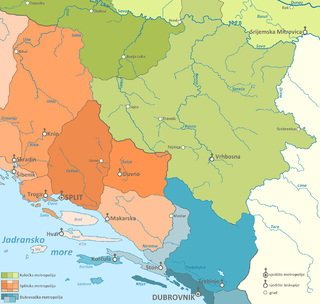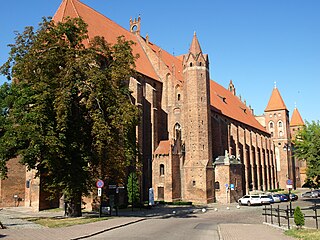History
The see of Amyclae dates to 1082, when the Bishopric of Lacedaemon was raised to the rank of a Metropolitan see, and authorized to form three suffragan sees at Amyclae, Pissa (probably encompassing Kynouria) and Ezeroi. Despite its name, the new bishopric was not located at ancient Amyclae, a town near Sparta, but rather on the site of ancient Tegea in Arcadia, which through some unclear process had received the name of Amyklion (later usually shortened to Amykli and Nikli) by the 10th century. The bishopric of Amyclae was thus regarded as the successor of the long-defunct see of Tegea, attested as late as the Fourth Ecumenical Council in 451, but later abandoned, like much of Arcadia, as a result of the Slavic incursions of the late 6th century. The only known bishop of the see's early period is Nicholas Mouzalon in the second half of the 12th century.
Latin bishopric
Nikli and the rest of Arcadia were captured by the Crusaders in circa 1206–09, becoming part of the new Frankish Principality of Achaea, which soon came to encompass most of the Peloponnese. The Chronicle of the Morea depicts Nikli as a site of some importance and fortified, which fell to the Crusaders only after a siege.
It became the seat of a secular barony, while a Roman Catholic bishop was installed in the episcopal see: the bishop Gilbert of Amyclae is attested in an act of September 1209.
In 1222, the bishopric was united with the Metropolitan see of Lacedaemon.
Titular Latin see
It is a suppressed titular see of the Catholic Church, counting 18 incumbents between 1541 and the death of the last holder in 1937. [12]
It has had the following incumbents, all of the lowest (episcopal) rank :
- Scipione Rebiba (1541.03.16 – 1551.10.12) as Auxiliary Bishop of Chieti (Italy) (1541.03.16 – 1551.10.12); later Bishop of Mottola (1551.10.12 – 1556.04.13), created Cardinal-Priest of S. Pudenziana (1556.01.24 – 1565.02.07), Metropolitan Archbishop of Pisa (Italy) (1556.04.13 – 1560.06.19), Bishop of Troia (Italy) (1560.06.19 – 1560.09.04), created Cardinal-Priest of S. Anastasia (1565.02.07 – 1566.10.07), Titular Latin Patriarch of Constantinople (1565.12.08 – 1573.04.08), Cardinal-Priest of S. Angelo in Pescheria (pro hac vice Title 1566.10.07 – 1570.07.03), Cardinal-Priest of S. Maria in Trastevere (1570.07.03 – 1573.04.08), promoted Cardinal-Bishop of Albano (1573.04.08 – 1574.05.05), Cardinal-Bishop of Sabina (1574.05.05 – 1577.07.23)
- Archbishop Pietro Vico (1635.09.17 – 1641) as Coadjutor Archbishop of Oristano (Italy) (1635.09.17 – 1641), succeeded as Metropolitan Archbishop of Oristano (1641 – 1657.08.27), later Metropolitan Archbishop of Cagliari (Sardinia, Italy) (1657.08.27 – 1676.10.19)
- Bishop-elect Francisco Ocampo, Military Order of Saint James of the Sword (O.S.) (1660.06.21 – ?), never held episcopal office
- Franz Christoph Rinck von Balderstein (1684.05.15 – 1707.05.06)
- Johann Kasimir Röls (1708.03.12 – 1715.02.08)
- Joseph Anton Reichfreiherr von Delmestri von Schönberg (1718.05.11 – 1720.04.23)
- Francisco Sánchez Márquez (1720.05.27 – 1728.09)
- Johann Ferdinand Joseph von Boedigkeim (1730.11.22 – 1756.04.28)
- Emmanuel Ernst Reichsgraf von Waldstein (1756.05.23 – 1760.01.28)
- Albert-Simon d’Aigneville de Millancourt (1760.09.22 – 1793.10.26)
- Jean-Baptist-Marie-Anne-Antoine de Latil (1816.03.08 – 1817.10.01), later Bishop of Chartres (France) (1817.10.01 – 1824.07.12), Metropolitan Archbishop of Reims (France) (1824.07.12 – 1839.12.01), created Cardinal-Priest of S. Sisto (1829.05.21 – 1839.12.01)
- Thomas Weld (1826.05.23 – 1830.03.15), as Coadjutor Bishop of Kingston (Canada) (1826.05.23 – 1830.03.13 not possessed); later created Cardinal-Priest of S. Marcello (1830.07.05 – 1837.04.10)
- Francesco Gentilini (later Archbishop) (1832.09.15 – 1833.04.15)
- Bishop-elect Antonio Herrán y Zaldúa (1834.01.20 – 1855.01.21) later Metropolitan Archbishop of Santafé en Nueva Granada (Colombia) (1855.01.21 – 1868.02.06)
- William Weathers (1872.09.27 – 1895.03.04)
- Patrick Foley (1896.03.18 – 1897.12.19)
- Patrick Fenton (1904.04.16 – 1918.08.22)
- Franciscus Hubertus Schraven (文致和), Lazarists (C.M.) (1920.12.16 – 1937.10.10)
Orthodox see
Nikli was still in Frankish hands in 1280, but was lost to the resurgent Byzantines by 1302. With the progressive Byzantine recovery of much of the Peloponnese in the late 13th and early 14th centuries, the Orthodox clergy was reinstated in many of its former sees, and new ones were founded; thus in the mid-14th century, Amyclae was once more made a bishopric, again as a suffragan of the Metropolis of Lacedaemonia. The Orthodox see continued in existence thereafter: in 1562 it is recorded as the first-ranked ( protothronos ) among the suffragans of Lacedaemon.
In the aftermath of the Orlov Revolt and the invasion of the Peloponnese by Albanian irregulars, its bishop, Cyril, fled to Zakynthos and thence (along with the bishops of Lacedaemon and Monemvasia and other refugees) aboard four Russian warships to the Crimea.
In 1804, the see of Amyclae was united with that of Tripolitsa into the Bishopric of Amyclae and Tripolitsa, with the bishop Nikephoros of Amyclae assuming the new see.
In May 1817, the see was elevated to the rank of a Metropolis, and in 1819, the bishopric of Olena was merged into it.
Following the establishment of the independent Kingdom of Greece and the autocephaly of the Church of Greece in 1833, it became the Metropolis of Mantinea and Megalopolis.

Tegea was a settlement in ancient Arcadia, and it is also a former municipality in Arcadia, Peloponnese, Greece. Since the 2011 local government reform it is part of the Tripoli municipality, of which it is a municipal unit with an area of 118.350 km2. It is near the modern villages of Alea and Episkopi.

Sarepta was a Phoenician city on the Mediterranean coast between Sidon and Tyre, also known biblically as Zarephath. It became a bishopric, which faded, and remains a double Catholic titular see.

The Latin Patriarchate of Alexandria was a nominal Patriarchate of the Latin church on the see of Alexandria in Egypt.

Tragurium, Ancient Latin name of a city in Dalmatia, now called Trogir, was a bishopric until 1829 and a Latin titular bishopric until 1933.

The Roman Catholic Archdiocese of Prague (Praha) is a Metropolitan Catholic archdiocese of the Latin Rite in Bohemia, in the Czech Republic.

Olba or Olbe was an ancient city and bishopric in the Roman province of Isauria, in present-day southern Turkey. It is included in the Catholic Church's list of Latin titular sees.

The Bishopric of Pomesania was a Catholic diocese in the Prussian regions of Pomesania and Pogesania, in modern northern Poland until the 16th century, then shortly a Lutheran diocese, and became a Latin titular see.

The Archdiocese of Strasbourg is a Latin Church ecclesiastical territory or archdiocese of the Catholic Church in France, first mentioned in 343 AD.

The Roman Catholic Diocese of Guadix is a Latin Catholic suffragan bishopric in the Ecclesiastical province of the Metropolitan of Granada in Andalusia, southern Spain and a Latin titular bishopric under its Ancient name of Acci. Its cathedral episcopal see is Nuestra Señora de la Anunciación, dedicated to Our Lady of the Annunciation, in the city of Guadix, administrative province of Granada. It was commenced in 1710, on the site occupied by the principal mosque, and completed in 1796.

The Roman Catholic Metropolitan Archdiocese of Rijeka is a Latin Catholic Metropolitan archdiocese in Croatia.

Ksar Sbahi is a town and commune in Oum El Bouaghi Province, Algeria and the site of Ancient Gadiaufala, a Roman city and former bishopric, now a Latin Catholic titular see.
Arsuz, also known as Uluçınar, is a municipality in Hatay Province, Turkey. In ancient times, it was known as Rhosus and was a former bishopric and titular see.

The Barony of Nikli was a medieval Frankish fiefdom of the Principality of Achaea, located in the southern Arcadia region of the Peloponnese peninsula in Greece, and centred on the town of Nikli, also known as Amyklai or Amyklion.
The Diocese of Lacedaemon was a Christian ecclesiastical province in Laconia, Greece. Extant from at least the middle of the 5th century, it became a metropolis in 1083. During the period of Frankish rule, between ca. 1209 and 1278, it was held by Roman Catholic prelates, and remains a (vacant) titular see of the Catholic Church. The Greek Orthodox see was restored with the Byzantine reconquest in the 1270s, and continued until the see's abolition in 1852.
Vinda was an Ancient city and bishopric in North Africa and is now a Latin Catholic titular see.
The Roman Catholic Archdiocese of Ohrid was a Latin Catholic archdiocese, suppressed in the 1700s, and is now a titular see, at modern Ohrid in North Macedonia.
The Metropolis of Elis and Olena is a Greek Orthodox episcopal see of the Church of Greece. During the period of Frankish rule it was a Roman Catholic see, and continues to the present day as a titular see in the Roman Catholic Church.
Caesariana (Cæsariana) was an Ancient city and diocese in Roman North Africa. It is now only a Roman Catholic titular see.
San Leone was a town and Catholic bishopric in Calabria, southern Italy, which remains a Latin titular see.
Sila was ancient city and bishopric in Roman North Africa, which remains a Latin Catholic titular see.
This page is based on this
Wikipedia article Text is available under the
CC BY-SA 4.0 license; additional terms may apply.
Images, videos and audio are available under their respective licenses.











